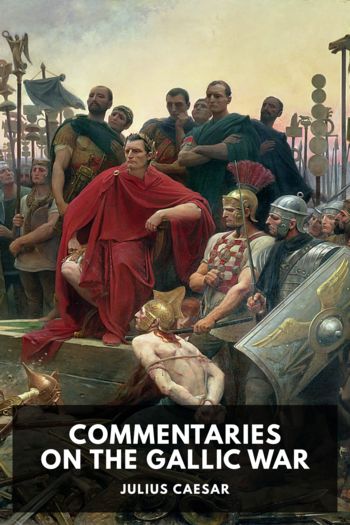Fateful Lightning: A New History of the Civil War & Reconstruction by Allen Guelzo (icecream ebook reader txt) 📗

- Author: Allen Guelzo
Book online «Fateful Lightning: A New History of the Civil War & Reconstruction by Allen Guelzo (icecream ebook reader txt) 📗». Author Allen Guelzo
Take this estate. John C. says he could rent it from his grandfather and give him fifty thousand a year—then make twice as much more for himself. What does it do, actually? It all goes back in some shape to what are called slaves here—operatives, tenants, &c elsewhere. … This old man’s [money] goes to support a horde of idle dirty Africans—while he is abused and vilifed as a cruel slave owner. … I hate slavery.55
Richard Taylor, a Louisianan and the son of a president, commented bitterly long after slavery had disappeared that “extinction of slavery was expected by all and regretted by none.” Even in the throes of slavery, enslaved African Americans imposed a strong psychological tension on their masters that robbed the whites of whatever joys there were to be had in owning another human being.56
And so, once again, the question emerged: why, if slavery held so much woe, not only for black slaves but for white masters as well, did Southerners cling to slavery as they clung to cotton agriculture? The easiest answer available was a Romantic one: because slavery promoted a peculiar culture, a certain way of living, for which white Southerners were willing to pay the price. “It was a medieval civilization, out of accord with the modern tenor of our time,” Fanny Andrews, a Georgian, recalled, as though she had been living rather than merely reading a Walter Scott novel. “It stood for gentle courtesy, for knightly honor, for generous hospitality; it stood for fair and honest dealing of man with man in the common business of life, for lofty scorn of cunning greed and ill-gotten gain through fraud and deception of our fellowmen. …” James Walker, a Charleston lawyer, went so far as to insist that “ours is in truth not so much slavery as feudality.” 57 This was an ingenious rationalization. The problem is that it is too simple.
The slave-based cotton agriculture of the Southern states was an intricate and complicated system in which appearances were not always uniform and not always the safest guide. Alongside the Romantic image of magnolias at midnight lay a relentless economic rationality; alongside the facade of racial reciprocity lay resistance and revolt; and alongside the casual tolerance of slave labor in producing their most lucrative commodity, Southerners displayed a fierce personal independence and a resentment at condescension and control. Southerners veered between assertions that theirs was a thoroughgoing slave society, in which “every fibre… is so interwoven with it, that it cannot be abolished without the destruction of the other,” and realizations that Southerners were as much participants in a liberal democratic order as any other Americans, though one inexplicably incorporating the quirk of slave labor. This uncertain swinging between two poles would come back to cripple them in the 1860s when Southerners had to decide whether the survival of slavery or the survival of Confederate nationalism was more important to them. 58
The South was divided in other ways as well. Geographically and socially, there were actually three slaveholding Souths, embracing masters, slaves, and nonslaveholding whites, and spread across an uneven and uncooperative geography. The first South anyone who crossed the Ohio River or the Mason-Dixon Line found was the Border South (Kentucky, Maryland, northern Virginia); below this lay the Middle South (Arkansas, northern Louisiana, Tennessee, southern Virginia, and the upcountry of Alabama, Mississippi, South Carolina, Georgia, and North Carolina); and bordering the Gulf and south Atlantic coastlines was the Deep South (New Orleans to Charleston).
In the Border South, cotton had long since ceased to be the dominant crop and slavery the primary labor system. There, soil exhaustion drove fortune-hunting planters southward, slaves in tow; or, for those who did not plan on moving themselves, the proximity of the border states to the free states of the North, making slave flight as easy as it would be anywhere in the South, would persuade planters who stayed to sell off their slaves to the Deep South at a tidy profit. Either way, slavery was an institution in motion, mostly southward. One North Carolinian who lived “on one of the great thoroughfares of travel… on the Yadkin River” recalled seeing “as many as 2,000 slaves in a single day going South” during the prewar years, “mostly in the hands of speculators.” By 1860, Virginia and Maryland had only 18 percent of all Southern slaves within their borders, and only a quarter of the South’s cotton output; less than a third of the populations of Delaware, Missouri, Kentucky, Maryland, Tennessee, and Virginia were slaves (compared to 57 percent in South Carolina, 45 percent in Alabama, 55 percent in Mississippi, and 47 percent in Louisiana). In eastern Tennessee, only 10 percent of the population were slaves, and most of Tennessee grew not cotton but wheat. 59 In this environment, it was easier to find the remaining slave owners imbued with the Romantic conviction that they were upholding, to their own financial loss, an economic system that preserved the ancient atmosphere of the castle, moat, and manor.
But move into Alabama, Mississippi, and Louisiana, and there the plantations not only were newer but also constituted some of the richest cotton- and sugarcane-growing soil on the face of the earth. Between 1790 and 1860, nearly a quarter of the slave population was moved into the new cotton states; the slave population of the Border States, meanwhile, fell by almost half. By the 1850s, large-scale cotton plantations and





Comments (0)